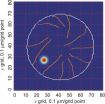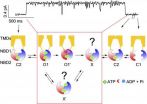(Press-News.org) A recent study in The Journal of General Physiology characterizes the movement of rhodopsin, a GPCR and member of a large family of transmembrane receptors responsible for many cellular responses and involved in many human diseases.
In living Xenopus rod photoreceptor cells, rhodopsin is found in stacks of disc membranes that are difficult to study due to their small size. Now, Peter Calvert (SUNY Upstate Medical University) and colleagues have developed an approach with two-photon microscopy that, for the first time, allows direct examination within the living cell of how the geometry of the micro-compartment will affect its signaling.
The team focused on the effect of micro-compartments formed by "incisures", radial membrane boundaries that segment the discs into smaller regions. These micro-compartments, defined by the rim and incisures, have a surface area similar to that of a human or mouse rod photoreceptor disc, so that the total number of components in the GPCR signaling cascade are conserved, and the downstream effects of a captured photon of light are similar. Calvert and colleagues used a novel high-resolution approach to monitor fluorescently labeled rhodopsin as it diffused in the disc membrane. The team developed a model of molecular diffusion to interpret the results that explicitly took the measured micro-compartments into account, and found that the boundary geometry, not heterogeneity in diffusion or a "bound fraction," was sufficient to explain differences in the extent of diffusion or rhodopsin in different regions of the disc.
INFORMATION:
About The Journal of General Physiology (JGP
Founded in 1918, JGP is published by The Rockefeller University Press. All editorial decisions on manuscripts submitted are made by active scientists. JGP content is posted to PubMed Central, where it is available to the public for free six months after publication. Authors retain copyright of their published works and third parties may reuse the content for non-commercial purposes under a creative commons license. For more information, please visit www.jgp.org.
Najafi, M., et al. 2012. J. Gen. Physiol. 140:249.
Adler, E.M. 2012. J. Gen. Physio. 140:341.
Geometry plays a role in GPCR transmembrane signaling
2012-09-26
ELSE PRESS RELEASES FROM THIS DATE:
University of Kentucky research sheds light on pain pill abuse
2012-09-26
LEXINGTON, Ky. (Sept. 26, 2012) — A study by a team of University of Kentucky researchers has shed new light on the potential habit-forming properties of the popular pain medication tramadol, in research funded by the National Institute on Drug Abuse. The paper is slated to appear in an upcoming edition of the academic journal Psychopharmacology.
Prescription pain killer abuse is a major public health problem in the U.S. In 2010, more individuals over the age of 12 reported nonmedical use of prescription pain relievers in the past month than use of cocaine, methamphetamine ...
New insights into functionality of cystic fibrosis protein
2012-09-26
CFTR is an important protein that, when mutated, causes the life-threatening genetic disease cystic fibrosis. A study in The Journal of General Physiology (JGP) details how an accidental discovery has provided new understanding about CFTR functionality.
From a scientific standpoint, CFTR is unique in that it is the only known ion channel—a protein pore that enables the passive diffusion of ions across cell membranes—in the enormous superfamily of ABC proteins, which normally operate as active transporters. As active transporters, ABC proteins use energy derived from ...
Paper: Federal law needed to safeguard 'digital afterlives'
2012-09-26
CHAMPAIGN, Ill. – Federal law ought to play a stronger role in regulating social networking sites by allowing users to determine what happens to their "digital afterlives," says a recently published paper by a University of Illinois expert in intellectual property law.
Allowing social networking sites to set their own policies regarding the content associated with the accounts of deceased users does not adequately protect individual and collective interests, especially with people spending an increasing part of their lives online using social networking sites, says Jason ...
Duke Medicine news -- Protein structure unlocks 1 mystery of multi-drug tolerance
2012-09-26
DURHAM, N.C. – The structures of key bacterial proteins have revealed one of the biochemical secrets that enables bacteria to outwit antibiotics.
In a paper published Sept. 20, 2012 in the journal Cell Reports, Duke University School of Medicine researchers and their colleagues describe the results of a series of experiments exploring multi-drug tolerance, a phenomenon that allows bacteria to become dormant and tolerate antibiotics, only to later awaken and re-infect the host. Drug tolerance is a factor in several types of stubborn, recurring infectious diseases caused ...
Taking the battle against the toxic trio beyond 'Leaves of 3, leave it be'
2012-09-26
With more than half of all adults allergic to poison ivy, oak and sumac, scientists are reporting an advance toward an inexpensive spray that could reveal the presence of the rash-causing toxic oil on the skin, clothing, garden tools, and even the family cat or dog. Using the spray, described in ACS' The Journal of Organic Chemistry would enable people to wash off the oil, or avoid further contact, in time to sidestep days of misery.
Rebecca Braslau and colleagues explain that allergic reactions to oils of the toxic trio are more than a nusiance. They claim a huge human ...
Bigger wind turbines make greener electricity
2012-09-26
WASHINGTON, Sept. 26, 2012 — The latest episode in the American Chemical Society's (ACS') award-winning Global Challenges/Chemistry Solutions podcast series concludes that the larger the wind turbine, the greener the electricity it produces. The study could solidify the trend toward construction of gigantic windmills.
Based on a report by Marloes Caduff in ACS' journal Environmental Science & Technology, the new podcast is available without charge at iTunes and from www.acs.org/globalchallenges.
In the new episode, Caduff, a graduate student, and Stefanie Hellweg, ...
Exposure to snot-nosed kids ups severity of cold infections
2012-09-26
Exposure to school-age children raises the odds that a person with lung disease who catches a cold will actually suffer symptoms like a runny nose, sore throat and cough, according to a study just published in the Journal of Clinical Virology.
That finding, the result of a study that drew upon a databank of 1,000 samples of sputum and nasal secretions from people with chronic obstructive pulmonary disease or COPD, comes as a surprise, says Ann Falsey, M.D., professor of Medicine at the University of Rochester and an infectious disease expert at Rochester General Hospital. ...
Buddhist statue, discovered by Nazi expedition, is made of meteorite, new study reveals
2012-09-26
It sounds like an artifact from an Indiana Jones film; a 1,000 year-old ancient Buddhist statue which was first recovered by a Nazi expedition in 1938 has been analysed by scientists and has been found to be carved from a meteorite. The findings, published in Meteoritics and Planetary Science, reveal the priceless statue to be a rare ataxite class of meteorite.
The statue, known as the Iron Man, weighs 10kg and is believed to represent a stylistic hybrid between the Buddhist and pre-Buddhist Bon culture that portrays the god Vaisravana, the Buddhist King of the North, ...
Women twice as likely to suffer infection with kidney stones and other urinary blockages
2012-09-26
DETROIT– While more men than women develop kidney stones and other obstructions in the urinary tract, women are more than twice as likely to suffer infections related to the condition, according to a new study led by Henry Ford Hospital researchers.
The researchers also found significantly higher rates of complications following one of two urgent treatments for the effects of urolithiasis – or stones in the kidneys and urinary tract – but stressed that this finding is based on preliminary and more research is needed.
The findings were published today in the peer-reviewed ...
Tracking koala disease: New findings from old DNA
2012-09-26
DNA extracted from the skins of koalas displayed in European and North American museums shows that a retrovirus has been a problem for the animals for much longer than was thought, according to Alfred Roca, an assistant professor of animal sciences at the University of Illinois, and Alex Greenwood of the Leibniz Institute for Zoo and Wildlife Research (LZW) in Berlin.
"The process by which a retrovirus invades the host germ line appears to be quite drawn out in this case, so that the koala population has suffered the strongly pathological effects of the virus for many ...


